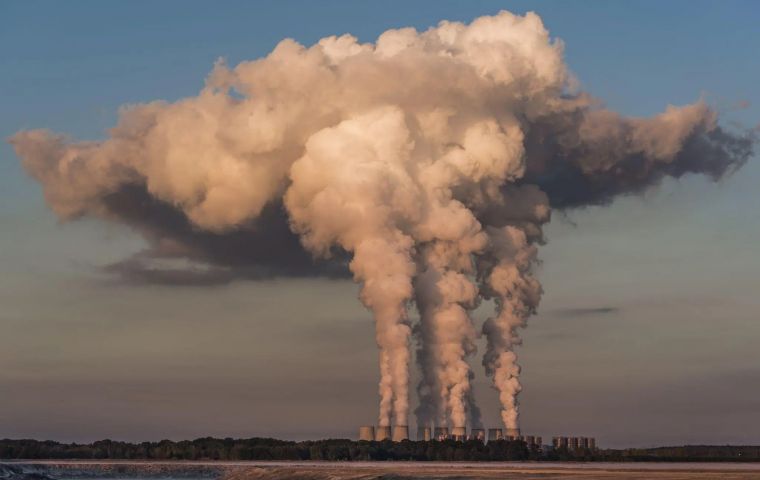MercoPress. South Atlantic News Agency
Cutdown in carbon dioxide emissions reported in Brazil last year
 The lowest emissions were recorded in 2009
The lowest emissions were recorded in 2009 South America's largest country cut down its carbon dioxide equivalent (GtCO2e) emissions by 12% in 2023 compared to the previous year, Agencia Brasil reported Thursday citing data from the Climate Observatory. In 2023, Brazil emitted 2.3 billion tons of greenhouse gases, already a reduction from 2022's 2.6 billion tons.
According to the observatory, this is the biggest percentage drop in emissions since 2009, when the country recorded the lowest emissions in the historical series that began in 1990 (1.77 billion GtCO2e). The drop in deforestation in the Amazon was the main reason for the reduction in emissions. Emissions from deforestation in the rainforest fell by 37%, from 1.074 billion tons of carbon dioxide equivalent to 687 million tons.
On the other hand, data from the Observatory's Greenhouse Gas Emissions Estimates System (SEEG) show that, despite the slowdown in the Amazon, the devastation of the other biomes resulted in the emission of 1.04 GtCO2e gross in 2023.
According to SEEG Coordinator David Tsai, the reduction in emissions is good news, but it highlights the dependence on what happens in the Amazon, especially if the country is to achieve its Nationally Determined Contribution (NDC). The new NDCs must be presented by February 2025 and must be aligned with the first Global Stocktaking of the Paris Agreement (GST), which ends in 2023 at COP28 in Dubai.
“The drop in emissions in 2023 is certainly good news,” said Tsai. It “puts the country on the right track to meet its NDC, the national climate plan for 2025,” he added. “At the same time, it shows that we are still overly dependent on what happens in the Amazon, as policies for other sectors are timid or non-existent. This will have to change in the new NDC, which will be proposed later this year. Brazil needs a consistent decarbonization plan that will really transform the economy.”
Regarding the other biomes, the survey showed that emissions from deforestation and biomass burning have increased: 23% in the Cerrado, 11% in the Caatinga, 4% in the Atlantic Forest, and 86% in the Pantanal. In the Pampa, these emissions fell by 15%, but the biome only accounts for 1% of the total.
“Brazil is seeing the fight against deforestation in the Amazon having an effect. But meanwhile, deforestation in other biomes, such as the Cerrado and the Pantanal, is accelerating. This 'leakage' is not something new and it needs an urgent solution if we are to continue to have a chance of meeting Brazil's mitigation targets,” said Bárbara Zimbres, a researcher at the Amazon Environmental Research Institute (IPAM), which is responsible for calculating land use emissions in the SEEG.
Changes in land use accounted for almost half of the country's greenhouse gas emissions (46%), with 1.062 billion tons of CO2e. According to the observatory, agriculture recorded its fourth consecutive record in emissions, up 2.2%. As a result, this economic activity accounted for 28% of Brazil's gross emissions last year, mainly due to the increase in the cattle herd.
“Most of the emissions come from enteric fermentation (the popular ox ”burp”), with 405 million tons in 2023 (more than Italy's total emissions),“ the institution points out. ”Adding in emissions from land use change, farming, and cattle-raising continues to be by far the biggest emitter in the country, with 74% of the total,” it continued.
Gabriel Quintana, a climate science analyst at the Institute for Forest and Agricultural Management and Certification (Imaflora), recalled that the last reduction in emissions from Brazilian agriculture was recorded in 2018. Since then, they have been increasing and setting records. Imaflora is the organization responsible for calculating agricultural emissions in the SEEG.
“They are driven by the increase in the cattle herd, the use of limestone and synthetic nitrogen fertilizers, after all, Brazilian production has been growing. The challenge for the sector, which is very susceptible to the impacts of the climate crisis, is to align the mitigation of greenhouse gas emissions with productivity efficiency, especially the reduction of methane and the adoption of systems that generate carbon sequestration in the soil,” he said.
In the waste and energy sectors, the growth in carbon dioxide equivalent emissions was 1% and 1.1%, respectively. These results stemmed from the increase in diesel oil, gasoline, and aviation kerosene consumption last year. Together, they caused a 3.2% rise in transportation emissions, which reached a record 224 MtCO2e).
“This increase more than offset the reduction in emissions due to the 8% drop in electricity generation by fossil thermoelectric plants last year, in which there was no water crisis to impact hydroelectric generation. In total, energy and industrial processes emitted 22% of the national total, 511 MtCO2e,” the report also mentioned.
Emissions from burning pasture and native vegetation (not counted as deforestation) fell by 38% and 7% in 2023, respectively. These emissions were left out of the national inventory, but are becoming increasingly important as climate change increases the risk of fire, including in humid forests.




Top Comments
Disclaimer & comment rules-

Read all commentsCommendable!
Nov 13th, 2024 - 12:12 pm 0But, in a lighter vein.
“Most of the emissions come from enteric fermentation (the popular ox ”burp”), with 405 million tons in 2023 (more than Italy's total emissions)”
Commenting for this story is now closed.
If you have a Facebook account, become a fan and comment on our Facebook Page!